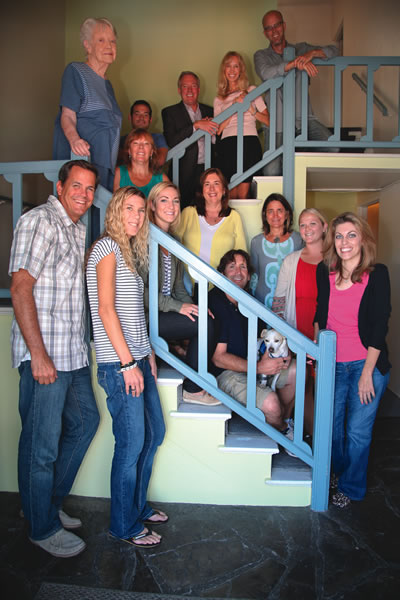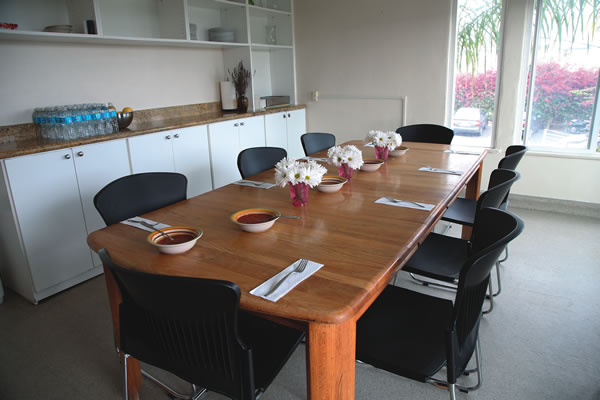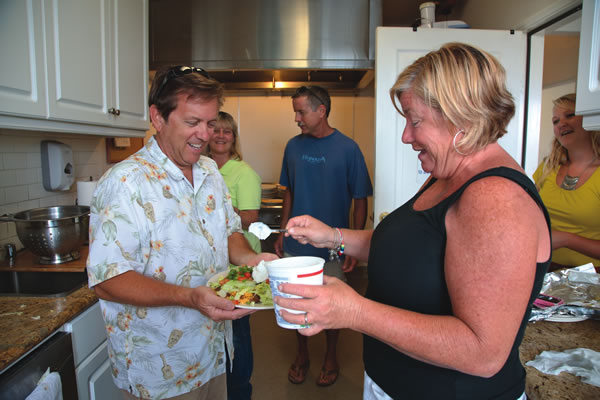Friendship Shelter has given Laguna Beach’s homeless more than just a place to sleep.
By Patrick Mott | Photos by Jody Tiongco

Twenty-five years ago, living on the streets of Laguna Beach was a dead end. Many of the homeless would spend their lives ricocheting from panhandling to prison, from hard drugs to halfway houses, locked in an ever-accelerating downward spiral. Every night, including Christmas Eve, the pews—and the floor—of St. Mary’s Episcopal Church on Park Avenue would fill with the homeless and hopeless, where they would be given a blanket, and a safe and dry place to spend the night.
Then a group of Laguna Beach residents, organized in part by an English Episcopal priest who had been working at St. Mary’s, decided that simply feeding and sheltering the city’s street population wasn’t enough. Rehabilitation—in effect, helping them to reclaim lives of sobriety, sufficient employment and a roof over their heads—had to be the answer.
The result became one of Laguna Beach’s most enduring social successes, Friendship Shelter, which celebrates its 25th anniversary this year.
Inside the Shelter
A former residential hotel on South Coast Highway in the heart of the city’s business district, Friendship Shelter is low-profile in both appearance and function, but in the last quarter century it has served more than 6,000 Orange County homeless with a success rate—based on former residents that have found “stable housing, sustained employment and sobriety”—hovering around 70 percent. The institution is not a simple way station for the chronically down-and-out.
On a typical weekday mid-morning, most of the 32 residents of Friendship Shelter—19 men downstairs and 13 women upstairs in dorm-style rooms with bunk beds and communal shower and bathroom facilities—are out in town, mostly looking for jobs, working or volunteering. Getting a job, says the shelter’s outreach manager Taylor Mathieson, is paramount, since 80 percent of all residents’ earnings go into a savings account intended to eventually be used for a security deposit on a place to live when residents are ready to start living on their own.
The shelter is a kind of oasis, containing all the essentials a formerly homeless person needs to navigate a typical week: a dining room with free meals (including sack lunches) cooked and served by volunteers, a “resource room” with computers, a laundry area, a donation room filled with food and clothing suitable for job interviews, a small library and a communal room for regular meetings with staff and residents. All residents are assigned specific chores. Several regular classes are offered in such subjects as financial fitness, job interview techniques and self-esteem building. There are mental health support groups, Alcoholics Anonymous and other 12-step meetings, and assisted access to local doctors, dentists and other service providers.
Random drug tests and room inspections are conducted periodically. There is a waiting list for admission to Friendship Shelter, and residents must pass a drug test in order to be approved for admission to the program.
Taylor estimates that 60 to 65 percent of the residents are in recovery from alcohol or drugs and about half have mental health issues. “With others it can just be bad luck or a chain of bad decisions,” she says. “Some are health-challenged and come from hospitals; some come from jail and don’t know how to transition into society yet; some have been living on the street or in cars. We get a lot of the ‘couch surfing’ population—people who may be homeless for the first time and don’t know how to navigate the system. It’s hard to put your life together when you’re constantly moving like that.”
Making a Difference
“[Homelessness] has changed a lot in the last 30 to 35 years, starting with the government’s releasing a lot of people from mental health institutions and stopping the institutionalization of people with serious mental illness—which is a very complicated issue,” says Friendship Shelter Executive Director Dawn Price. “People shouldn’t be locked up if they don’t have to be locked up. But what happened is they let people out without any alternative treatment options, so people ended up on the street. And to this day that is an ongoing problem. It doesn’t surprise me that Laguna Beach was among the first places in Orange County to have a compassionate solution. We’re an extremely forward-thinking and compassionate community.”
And also a wealthy one—still, says Dawn, Friendship Shelter has enjoyed support across the local social and political spectrum.
“This is not a left-right issue,” she says. “This is a common sense issue. There are lots of reasons why people who line up on the right side of the political spectrum support us. … We’re helping save tax dollars by getting people back on their feet and back out into the community, and turning them into taxpayers. And even in the case of people who can’t work because of their mental health disabilities, we’re saving a lot of money by helping them live in a less costly setting than an emergency shelter. The people who live on the streets spend a lot of time in jails—very expensive. A lot of time in emergency rooms—very expensive. A lot of time in emergency shelters—very expensive. But housing is far less expensive.”
One of the keys to such across-the-board support, Dawn says, has to do with simple empathy.
“One of the big ‘Aha!’ moments for anyone who comes in here, volunteers and gets involved—or works here, for that matter—is that the big difference between a person in this shelter and someone in our own family is what’s available to them in terms of family support and a safety net. … All of us have a brother, a sister, a parent, a child who may have a mental health issue, an addiction issue. The difference is they don’t end up in a homeless shelter because people catch them and help them. People who end up here have either burned through those bridges or support systems, or never had them to begin with. So we become that support for them.”
The average stay at Friendship Shelter is four months, “but that tells you nothing,” Dawn says. “Some people decide it’s not for them and leave quickly. Some people can be here for a year or more. We will usually stick with someone who’s trying as hard or harder than we are. We have a young man who right now is doing incredibly well. But his first several weeks and even months here, he was coming off some pretty intense drug use. That messed him up psychologically for a while and we needed to wait him out on that. We have good staff here who are very highly trained and they were able to recognize that this was someone who was going to need some time.”
The Future of Friendship
Although Friendship Shelter is a nonprofit and not a faith-based organization, it began with—and continues to have—a broad base of local clerical and church support. Still, says the Rev. Colin Henderson, the Episcopal priest who hosted so many homeless at St. Mary’s beginning in 1985, the original idea for the shelter “seemed wildly improbable.”
But as the idea for the shelter gained traction, volunteers from Colin’s congregation, as well as from other churches and the community, and advisors from local and county mental health services, began to appear and organize. State and local grants materialized, and the property on South Coast Highway was purchased and fitted for the purpose.
“In the beginning, the shelter was very grass-roots, very mom-and-pop,” says former shelter board chair Jill Edwards. She adds that in the last decade, however, the organization has become “much more professional” and includes a facility in San Clemente called Henderson House, a kind of graduate program for residents transitioning from Friendship Shelter to life on their own. There is also a facility in Laguna Canyon known as the Alternative Sleeping Location, an ongoing joint operation of Friendship Shelter and the city of Laguna Beach, where the chronically homeless can have a bed for the night and a hot meal.
Future plans call for a permanent housing development for “the most vulnerable homeless who can’t live on their own without support,” Dawn says. The apartment-style residences would have staff on-site to help and counsel residents. Dawn explains that Friendship Shelter is currently working with a development partner and further plans likely will be announced later this year.
“We’ve had enough success to know we’re on the right track,” Colin says. “That’s the important thing. You can never sit back on your laurels and say, ‘Now we’ve got it.’ You have to work with people, and everybody’s different. The overall concept is sound; it’s valid and it’s working, but you always have to be attuned to the needs of the people of that particular time.” LBM






